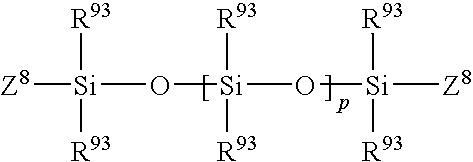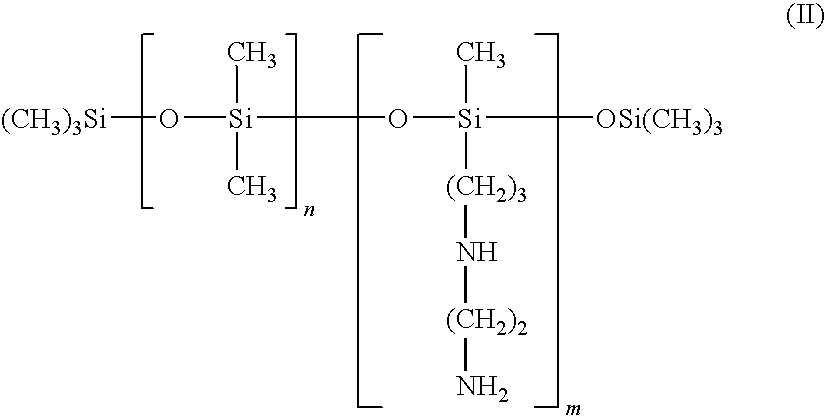Non-Lathering Personal Care Composition in the Form of an Article
a composition and non-lathering technology, applied in the field of non-lathering personal care compositions, can solve the problems of reducing the use reducing the use reducing the use effect of liquid products, so as to achieve the effect of reducing the use
- Summary
- Abstract
- Description
- Claims
- Application Information
AI Technical Summary
Benefits of technology
Problems solved by technology
Method used
Image
Examples
example 1
Polyvinyl Alcohol and Glycerin Pre-Mix
[0213]The following polymer premix compositions were prepared for use during the preparation of the dissolvable porous solids of the present invention:
Component1A1BDistilled water78.070.7Glycerin2.07.3Polyvinyl alcohola20.022.0Total100.0100.0a87-89% hydrolyzed, MW 85,000 to 124,000 available from Sigma Aldrich (Catalog Number 363081, batch 09501BE)
[0214]Into an appropriately sized and cleaned vessel, the distilled water and glycerin is added with stirring at 100-300 rpm. The polyvinyl alcohol is weighed into a suitable container and slowly added to the main mixture in small increments using a spatula while continuing to stir while avoiding the formation of visible lumps. The mixing speed is adjusted to minimize foam formation. The mixture is slowly heated to 85 C while continuing to stir and then allowed to cool to room temperature. The hazy mixture is allowed to sit overnight resulting in an amber colored clear solution.
example 2
Retail Liquid Hair Conditioner Product (Pantene Pro-V)
[0215]A liquid hair conditioner was purchased for use during the preparation of the dissolvable porous solids of the present invention. The product was Pantene Pro-V Always Smooth Conditioner, 750 ml, which was distributed by Procter and Gamble, Cincinnati, Ohio. The product was purchased in January 2008 with a lot number 71505395BC. The listed ingredients on the bottle were: water, stearyl alcohol, cyclopentasiloxane, cetyl alcohol, stearamidopropyl dimethylamine, glutamic acid, dimethicone, panthenol, panthenyl ethyl ether, benzyl alcohol, fragrance, EDTA, methylchloroisothiazolinone, methylisothiazolinone.
example 3
Retail Liquid Hair Conditioner Product (Matrix Biolage)
[0216]A liquid hair conditioner was purchased for use during the preparation of the dissolvable porous solids of the present invention. The product was Matrix Biolage Detangling Solution, 33.8 Fl. Oz., which was distributed by Matrix LLC, New York, N.Y. The product was purchased in February 2008 with a lot number GC048. The listed ingredients on the bottle were: water, cetearyl alcohol, behentrimonium methosulfate, cetyl alcohol, cyclopentasiloxane, behentrimonium chloride, phenoxyethanol, methylparaben, amodimethicone, fragrance, dimethiconol, stearamine oxide, propylene glycol, C11-15 pareth-7, C12-16 pareth-9, glycerin, trideceth-12, polysorbate 20, citric acid, sunflower extract, bitter almond kernel oil, wheat germ extract, hops extract, ext. violet 2, pollen extract, blue 1.
PUM
| Property | Measurement | Unit |
|---|---|---|
| density | aaaaa | aaaaa |
| thickness | aaaaa | aaaaa |
| thickness | aaaaa | aaaaa |
Abstract
Description
Claims
Application Information
 Login to View More
Login to View More - R&D
- Intellectual Property
- Life Sciences
- Materials
- Tech Scout
- Unparalleled Data Quality
- Higher Quality Content
- 60% Fewer Hallucinations
Browse by: Latest US Patents, China's latest patents, Technical Efficacy Thesaurus, Application Domain, Technology Topic, Popular Technical Reports.
© 2025 PatSnap. All rights reserved.Legal|Privacy policy|Modern Slavery Act Transparency Statement|Sitemap|About US| Contact US: help@patsnap.com



